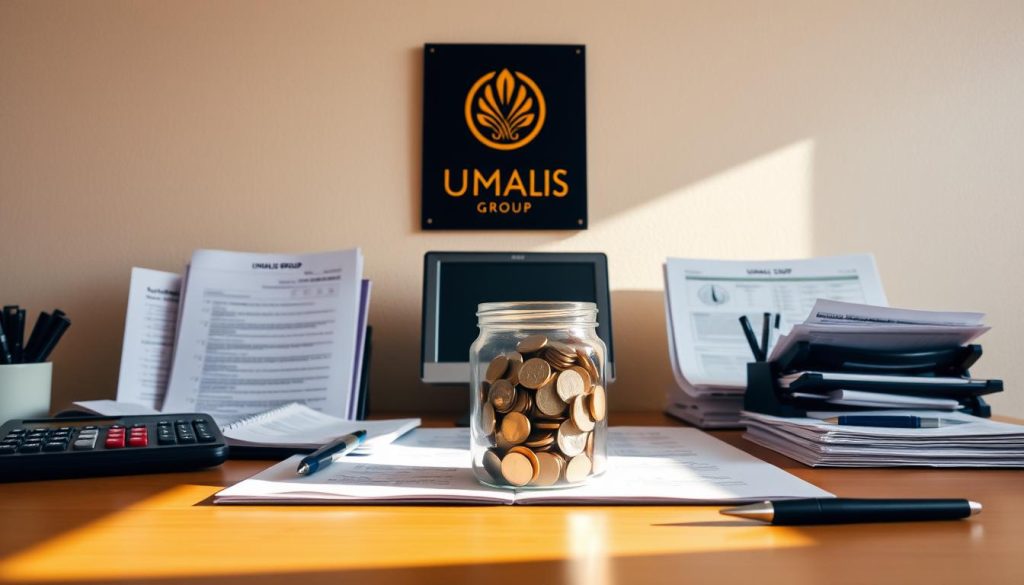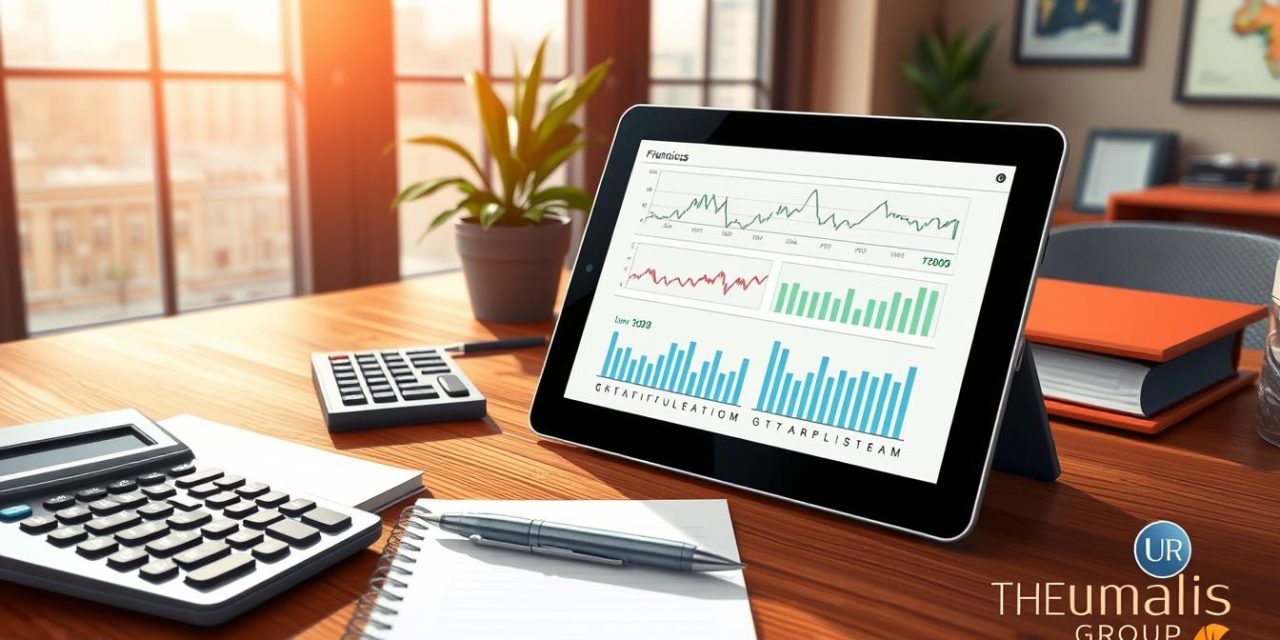Imagine waking up each morning knowing your choices align perfectly with the life you want to build. For many independent professionals, this starts with taking control of their money—but the journey often feels overwhelming. How do you balance today’s needs with tomorrow’s goals? That’s where Umalis steps in.
We’ve designed this guide to simplify the path toward stability. Whether you’re a freelancer, consultant, or entrepreneur, our tools—like the real-time income simulator—help you visualize different scenarios. What would your earnings look like in six months? How can taxes impact your savings? These answers are just a few clicks away.
This article isn’t just about numbers. It’s about reshaping your plan to match your ambitions. With Umalis, you’ll find step-by-step strategies to manage income, reduce uncertainty, and create lasting security. Our expertise comes from years of supporting professionals like you, blending technical know-how with genuine care.
Table of Contents
Key Takeaways
- Umalis offers tailored guidance for achieving long-term stability through smart money management.
- Interactive tools like income simulators provide clarity on real-world financial scenarios.
- Step-by-step strategies help align daily decisions with future goals.
- Designed specifically for independent professionals seeking confidence in their career choices.
- Combines technical expertise with practical, easy-to-use resources.
Introduction: Mapping Your Path to Financial Success
Clarity begins with a roadmap. For independent professionals, balancing daily priorities with long-term aspirations often feels like juggling without a net. Our step-by-step guide simplifies this challenge, offering a structured approach to align your income, time, and goals.
Overview of the How-To Guide
This resource breaks complex strategies into actionable steps. Start by analyzing your cash flow—understanding where your earnings go today helps redirect them toward tomorrow’s priorities. Tools like Umalis’ income simulator let you test scenarios, such as adjusting rates or increasing savings rates.
Independent workers often overlook time management’s role in retirement planning. Our guide shows how small, consistent choices compound into significant results. For example, automating 10% of monthly earnings can build security without disrupting cash flow.
Why It Matters for Independent Professionals
Without employer-backed benefits, self-employed individuals face unique risks. Partnering with a financial professional helps bridge this gap. Umalis combines expert insights with practical tools—like budget templates and tax calculators—to turn uncertainty into confidence.
Every chapter includes real-world examples: freelancers who doubled their savings, consultants optimizing invoices for growth. These stories prove that mastering personal finance isn’t about perfection—it’s about progress.
Understanding the Fundamentals of Money and Income

Mastering your resources starts with knowing where they go. Every euro you earn serves two purposes: immediate use or future growth. Let’s break down these concepts to build a strategy that works for your career.
Defining Money: Consumption vs. Investment
Consumption covers daily needs—groceries, rent, or subscriptions. These expenses keep life running but don’t grow your wealth. Investment, however, puts money to work. For example:
- Buying a course to boost freelance skills
- Setting aside funds in a high-yield savings account
- Purchasing equipment to increase service rates
A café owner who spends €200/month on specialty beans might see higher sales. That’s an investment. But buying designer coffee mugs? That’s consumption.
How Periodic Income Shapes Your Financial Future
Your annual income isn’t just a number—it’s raw material for stability. Consider a consultant earning €60,000/year. If they save 15% monthly:
- Year 1: €9,000 saved
- Year 5: €45,000 + compound interest
Small shifts matter. Reducing a €50/month streaming habit frees €600/year for emergency funds. Tracking payments and periods helps you spot these opportunities. As one Umalis user shared: “Automating savings felt impossible until I saw how €100/month added up.”
Setting Clear Financial Goals and Crafting Your Plan
What does your money landscape look like today? Start by mapping your income streams, recurring expenses, and existing savings. This snapshot reveals gaps and opportunities—like trimming underused subscriptions or redirecting surplus funds toward goals.
Assessing Your Current Financial Status
Use metrics like debt-to-income ratios and emergency fund coverage. For example, if monthly bills total €2,500, aim for €7,500 in accessible savings. Tools like Umalis’ income simulator let you test scenarios: “What if I earn 15% less next quarter?” or “How much can I save by renegotiating contracts?”
One graphic designer shared: “Tracking my project fees showed I was undervaluing my time by 20%.” Small adjustments create momentum.
Establishing a Budget and Savings Strategy
A flexible plan balances today’s needs with tomorrow’s priorities. Try the 50/30/20 framework:
- 50% for essentials (rent, utilities)
- 30% for discretionary spending
- 20% for savings and debt repayment
Automate transfers to a dedicated account each pay period. For irregular income, set baseline targets—like saving €300/month minimum, with bonuses added during peak months. Explore tailored strategies for freelancers to align cash flow with ambitions.
Every step builds confidence. As one consultant noted: “Seeing my simulated retirement balance grow keeps me motivated to stick to the plan.”
Navigating Investment Opportunities for Growth

Growing your wealth requires more than just saving—it demands strategic choices. Allocating your money across different assets helps protect against market swings while creating pathways for steady growth. Let’s explore how to build a resilient portfolio that aligns with your goals.
Diversifying Your Portfolio: Stocks, Bonds, and Real Estate
Spreading assets reduces reliance on any single investment. Consider this mix:
- Stocks: Shares in companies like L’Oréal or Renault offer growth potential but come with higher volatility.
- Bonds: Government or corporate bonds provide predictable returns, balancing stock market risks.
- Real Estate: Rental properties or REITs generate passive income and hedge against inflation.
During the 2008 crisis, diversified portfolios lost 30% less value than stock-heavy ones. This balance lets you recover faster while capturing growth opportunities.
Balancing Investment Risk and Return
Higher potential returns often mean accepting greater risk. A tech startup might promise a 20% rate of return, but established firms like Sanofi offer slower, steadier gains. Ask yourself:
- How much volatility can you tolerate?
- What timeline aligns with your goals?
- Does this investment complement existing assets?
One Umalis user shared: “Adjusting my stock-to-bond ratio gave me peace of mind during market dips.” Tools like our risk assessment calculator help you find your ideal balance without second-guessing.
Achieving Financial Independence
Building lasting stability requires more than a single income source. For professionals seeking flexibility, passive revenue streams and intentional career shifts create resilience against economic shifts. Let’s explore how to diversify earnings while aligning work with long-term goals.
Building Passive Income Streams
Passive income reduces reliance on active work. Consider these proven methods:
- Rental properties: A Paris-based designer earns €1,200/month renting a studio apartment purchased with savings from freelance projects.
- Dividend stocks: Allocating 15% of monthly income to shares in companies like LVMH generates quarterly payouts.
- Digital products: Online courses or templates can yield €500-€2,000/month with minimal upkeep after initial creation.
Studies show households with 3+ income streams are 68% less likely to face cash shortages during job transitions.
Steps to Transition from Salary Dependence
Shifting away from traditional employment requires strategy. Follow this roadmap:
- Automate savings: Redirect 20% of each payment to a high-yield account. Over 5 years, this builds a €24,000 safety net (assuming €2,000/month income).
- Reduce fixed costs: Negotiate lower rent or switch to budget-friendly utilities to free €300-€500 monthly.
- Develop side skills: A Lyon-based teacher now earns 40% of her income through weekend photography gigs.
As one Umalis user shared: “Using their retirement planning tools helped me see I could reduce work hours at age 55 without sacrificing security.”
Balance is key. Many maintain part-time roles while building passive ventures—a consultant might work 3 days/week while managing rental properties. This phased approach minimizes risk while accelerating progress toward your ideal retire age.
Effective Budgeting and Expense Management Strategies
Small daily choices shape your long-term stability. For independent professionals, managing cash flow isn’t just about cutting costs—it’s about aligning spending with priorities. Start by identifying patterns that quietly drain resources, like upgraded subscriptions or impulse purchases. These habits often grow unnoticed, creating lifestyle creep that derails budgets.
Reducing Lifestyle Creep and Optimizing Spending
Track every euro for 30 days using apps like Bankin’ or Umalis’ expense tracker. Categorize costs into “essentials” and “extras.” A Marseille-based freelancer discovered 15% of her income went to unused software subscriptions—a fix that saved €1,800/year. Ask: “Does this purchase support my goals or just momentary comfort?”
Try these steps to optimize spending:
- Negotiate recurring bills (internet, insurance) annually
- Replace dining out with meal-prepping clubs
- Use cash-back tools like Shopmium for groceries
Regular reviews keep adjustments on track. One consultant reduced dining expenses by 40% without sacrificing social time—he hosted potlucks instead of restaurant meetups. Step back quarterly to assess progress. Did your gym membership usage justify the cost? Could bundled services lower fees?
Minor tweaks could reduce annual outflows significantly. For example, swapping branded products for generic alternatives saves the average household €450/year. Pair this with automated savings transfers to build resilience. As one Umalis user shared: “Setting a ‘24-hour rule’ for non-essential buys helped me cut impulse spending by 60%.”
Remember, effective budgeting isn’t restriction—it’s intentionality. Each step ensures your resources fuel what matters most.
Leveraging Tax-Advantaged Accounts for Future Savings
Smart savers know tax-friendly tools amplify growth over time. Choosing the right account options can mean keeping thousands more euros through retirement. Let’s explore how these vehicles work—and why they matter for independent professionals.
Understanding 401(k)s, IRAs, and Health Savings Accounts
Tax-advantaged accounts offer unique benefits:
- 401(k)s: Employer-sponsored plans let you contribute pre-tax income. For every €1,000 saved annually, you reduce taxable income by €240 (assuming a 24% tax bracket).
- IRAs: Self-managed retirement accounts grow tax-free. A €5,000/year investment at 7% return becomes €405,000 in 30 years—€120,000 more than taxable savings accounts.
- HSAs: Triple-tax-free insurance tools for medical expenses. Contributions, growth, and withdrawals are untaxed if used for qualified costs.
| Account Type | 2024 Contribution Limit | Key Benefit |
|---|---|---|
| 401(k) | €23,000 | Employer matching up to 6% salary |
| IRA | €7,000 | Flexible investment options |
| HSA | €4,150 | No expiration on unused funds |
Unlike standard bank accounts, these tools prioritize long-term growth. For example, €500/month in a 401(k) at age 30 grows to €1.2 million by 65—even with market fluctuations. Umalis’ retirement simulator shows how adjusting contributions impacts your nest egg.
“Maxing my HSA let me cover dental surgery tax-free while building emergency funds.”
Blend account options to match your needs. Younger professionals might prioritize Roth IRAs for tax-free withdrawals later. Those with high-deductible insurance plans benefit most from HSAs. Regular reviews ensure your strategy evolves with tax laws and income changes.
Utilizing Umalis Tools and Expert Advice
Your journey to stability thrives on clarity and adaptability. Umalis combines cutting-edge technology with human insight to help you make informed choices. Whether adjusting your savings rate or exploring new income streams, their resources bridge the gap between uncertainty and confidence.
Exploring Umalis’ Online Financial Simulators
Umalis’ interactive tools turn abstract goals into actionable steps. For example, their income simulator lets you test scenarios like:
- How a 10% rate increase impacts annual earnings
- Projected savings growth with automated transfers
- Tax implications of freelance vs. salaried income
A Marseille-based designer used the tool to discover they could retire 4 years earlier by adjusting their plan. Real-time graphs show how small changes compound over months and years.
“The simulator revealed hidden opportunities—like redirecting €200/month from unused subscriptions to emergency funds.”
How Personalized Resources Can Enhance Your Plan
Generic advice often misses the mark for independent professionals. Umalis’ team analyzes your unique situation—project income, regional tax laws, and lifestyle goals—to craft tailored strategies. Their dashboard tracks:
| Metric | Generic Planner | Umalis Tools |
|---|---|---|
| Income Forecasting | 6-month estimates | 24-month simulations |
| Tax Optimization | Basic deductions | Location-specific strategies |
| Risk Analysis | Generalized tiers | Customized portfolio reviews |
Regular updates keep your plan aligned with evolving needs. As one user noted: “Their experts helped me pivot when a client loss threatened my savings goals—something automated tools couldn’t address.”
With 83% of users reporting improved confidence in their plan within 90 days, Umalis proves that smart tools paired with expert advice create lasting results.
Early Retirement Planning and Long-Term Health Care Considerations
Retiring early requires more than savings—it demands foresight for life’s uncertainties. Balancing today’s lifestyle with future health needs separates sustainable plans from wishful thinking. Start by calculating your target age and mapping essential costs over 20-30 years.
Estimating Your Retirement Needs and Savings Goals
Experts recommend saving 33× annual expenses for lasting security. For example, if you spend €40,000/year, aim for €1.32 million. Umalis’ retirement simulator helps test scenarios:
- Adjusting withdrawal rates based on market conditions
- Factoring in inflation’s impact over time
- Projecting healthcare costs rising 5% annually
One Bordeaux consultant discovered delaying retirement by 2 years reduced her required amount by €180,000. Tools like these turn abstract numbers into actionable steps.
Planning Ahead for Health Insurance and Social Security
In France, Medicare starts at age 65—leaving early retirees to bridge 5-15 years. Explore options:
- Private health insurance averaging €200-€400/month
- Public social safety nets for low-income households
- Health savings accounts (HSAs) for tax-free medical funds
Consider both health risks and lifestyle goals. A Nice-based freelancer allocated €15,000/year for wellness retreats and specialist care. “Your plan should reflect how you want to live, not just survive,” she shared.
Review your strategy annually. Market shifts, policy changes, and personal health updates all require adjustments. With 72% of early retirees underestimating medical costs, proactive planning becomes your greatest asset.
Conclusion
Taking charge of your future begins with actionable steps today. This guide has outlined proven ways to build stability—from budgeting basics to strategic investments. Each part of your journey matters, whether optimizing accounts or planning for your target age.
Consistency transforms small efforts into lasting results. Reviewing your plan every year ensures it adapts to life’s changes. Tools like Umalis’ simulators help test scenarios, while smart options like tax-advantaged accounts amplify growth.
Make sure your strategy evolves with your career. Automate savings, diversify income streams, and leverage expert-built resources. Over time, these choices ’ll pay dividends in security and flexibility.
Start implementing one step at a time. With clear information and tailored tools, you’re equipped to shape a future that aligns with your ambitions. Umalis remains your partner in turning today’s decisions into tomorrow’s confidence.
FAQ
How do I balance spending on immediate needs vs. long-term investments?
Start by tracking monthly expenses using apps like Mint or You Need a Budget. Allocate 20% of income to high-yield savings accounts (e.g., Ally Bank) and low-cost index funds (e.g., Vanguard). Adjust ratios based on your emergency fund status and debt levels.
What tax-advantaged accounts work best for freelancers?
Solo 401(k)s through providers like Fidelity and SEP IRAs offer higher contribution limits. Pair these with a Health Savings Account (HSA) from providers like Lively to reduce taxable income while saving for medical costs.
Can Umalis help if I want to retire before 50?
Yes. Our tools analyze income streams from rentals, dividends, or side businesses. For example, using Fundrise for real estate or M1 Finance for automated investing can accelerate timelines. Book a session with our advisors to customize your strategy.
How do I avoid lifestyle inflation as my income grows?
Automate savings increases whenever you earn more. Apps like Digit or Qapital can redirect raises/bonuses to investment accounts. Review spending quarterly using Personal Capital to spot trends and adjust habits.
What health insurance options exist for early retirees?
Consider COBRA for short-term coverage, then transition to marketplace plans via Healthcare.gov. Pair with an HSA for tax benefits. Umalis partners with brokers to compare providers like Blue Cross Blue Shield for optimal coverage-to-cost ratios.
How reliable are Umalis’ financial simulators for planning?
Our tools integrate real-time data from sources like YCharts and Morningstar, testing scenarios against historical market cycles. For accuracy, they account for inflation rates from the Federal Reserve and adjust for your risk tolerance.





